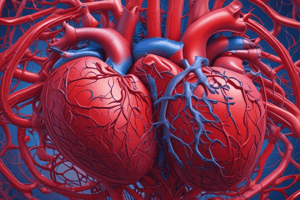Podcast
Questions and Answers
What are the properties of the heart related to its function?
What are the properties of the heart related to its function?
- Automaticity and contractility (correct)
- Contractility and excitation
- Excitability and contraction
- Contraction and stimulation
What is the substrate of automatism in the heart?
What is the substrate of automatism in the heart?
- Undifferentiated muscle cells
- Nerve cells
- Sinoatrial node
- Myocytes of the working myocardium (correct)
Which component is considered as part of the substrate of automatism in the heart?
Which component is considered as part of the substrate of automatism in the heart?
- Hiss bundle (correct)
- Undifferentiated muscle cells
- Purkinje fibers
- Atrioventricular node
What phases are distinguished on the action potential (AMP) of a cardiomyocyte?
What phases are distinguished on the action potential (AMP) of a cardiomyocyte?
What phase is part of the distinguished phases on the action potential (AMP) of a cardiomyocyte?
What phase is part of the distinguished phases on the action potential (AMP) of a cardiomyocyte?
Flashcards are hidden until you start studying
Study Notes
Properties of the Heart Related to its Function
- The heart is a muscular organ that pumps blood throughout the body
- It has a high degree of automatism, meaning it can generate its own rhythmic contractions
- The heart is also a highly vascularized organ, receiving about 5% of the total cardiac output
Substrate of Automatism in the Heart
- The substrate of automatism in the heart is the sinoatrial (SA) node
- The SA node is a group of cells located in the right atrium that generates the electrical impulses that control the heart's rhythm
Components of the Substrate of Automatism
- The SA node is composed of pacemaker cells, which are specialized cardiomyocytes that have the ability to generate electrical impulses
- The SA node is also richly innervated by the autonomic nervous system, which modulates the heart's rhythm
Phases of the Action Potential (AMP) of a Cardiomyocyte
- The action potential of a cardiomyocyte has five distinct phases: Phase 0 (depolarization), Phase 1 (rapid repolarization), Phase 2 (plateau), Phase 3 (final rapid repolarization), and Phase 4 (diastole)
- Phase 0 is characterized by a rapid depolarization of the cardiomyocyte, triggered by the opening of voltage-gated calcium channels
- Phase 1 is a rapid repolarization of the cardiomyocyte, due to the closure of voltage-gated calcium channels and the opening of voltage-gated potassium channels
- Phase 2 is a prolonged plateau phase, during which the cardiomyocyte is contracted and the membrane potential is relatively stable
- Phase 3 is a rapid repolarization of the cardiomyocyte, caused by the closure of voltage-gated sodium channels and the opening of voltage-gated potassium channels
- Phase 4 is the diastolic phase, during which the cardiomyocyte is at rest and the membrane potential is stable
Studying That Suits You
Use AI to generate personalized quizzes and flashcards to suit your learning preferences.




